UPDATED REVIEW – February 22, 2014 – Roland HP507 & LX15 – Recommended – The Roland music company which founded in Japan in 1972, has produced high quality reliable digital pianos for many years and is recognized as a leader around the world for digital piano & keyboard technology which professionals and beginners enjoy playing. I have personally owned and played Roland pro keyboards and digital pianos and consider them one of the best brands out there. Their latest top of the line home cabinet digital upright pianos are called the HP507 and LX15 and believe it or not, they are assembled in the US in Roland owned factories by American workers…helping our economy (I always appreciate that). These two pianos sell for between $4500-$6500 normal discount selling price in the US and are identical in technology and functions except that the LX15 is in a polished finish contemporary compact piano cabinet and has slightly more audio power. Also, the top lid of the LX15 opens up like a little baby grand so the sound is directed up and out of the piano like it would in a grand or taller upright piano. The HP507 has a more traditional furniture cabinet and also comes in lower priced satin finish cabinets. Both pianos sound pretty amazing (at least they do to me) and are stimulating to play, especially if you are someone who has played piano for awhile and is experienced enough to know what a piano should really sound and play like. Roland also produces a lower priced line of home digital pianos called the RP
& F series which sells for under $2000 and a series of digital Grand pianos called
the RG & V pianos which are impressive and available at selected US piano stores.
NEW UPDATE: Roland has
just upgraded and replaced their HP507 &
LX15 with new improved models for 2014 which are called HP508 and LX15e. The all new key actions, piano sound
dynamics, pedaling, and other aspects of these new models have been
redesigned to offer even more piano playing realism. The differences between these 2 new models are cabinet and speaker system. Go to the following link to read my review of the new models: HP508 Review Continuing with this review, the HP507 is traditional cabinet is available in three finishes including the satin brown rosewood (left pic),
satin black, and the higher priced polished ebony cabinet. The polished ebony finish
is priced at about $700 more discount selling price (depending on the
local dealer) than the standard satin brown rosewood & satin black color.
For the standard colors the HP507 retails at $5499US and store discount price is approximately $4499US (depending on the local dealer). Other top of the line traditional cabinet digital pianos in other brands are around the same price for their models (give or take), so being at around $4500 and up for a top of the line traditional cabinet piano is not unusual.
| LX15 polished ebony |
The LX15 is the compact upright contemporary cabinet
version of the HP507 and comes in two
finishes; either the polished ebony or polished white which are both
very attractive and definitely my favorite of all the Roland models. The lid of
this model also lifts up (which exposes a classy looking red felt
interior) and allows the sound to come out of the top like a little baby
grand, and the key cover is a slow-close fold down mechanism which is very nice. Although
the LX15 is the highest priced of all the Roland models ($7295US retail –
store discount selling price approx $5999US) depending on the local store.
I really like the LX15
because the sound has even more presence when playing through this
upright cabinet and the design makes you feel like you are playing a
real acoustic piano. Some people may ask, “at that price maybe I should just get a regular acoustic upright piano instead?” That’s a fair question and I do personally play Yamaha, Kawai, and Steinway grand & upright pianos so I know what that playing experience is like. However, I would say in response that the Roland LX15 does give you a great amount of piano sound & key action control along with being able to practice privately through headphone jacks for silent practice. The playing experience is quite “organic” in my opinion and similar to playing a high quality upright or grand piano. In fact, these Roland digital pianos rival some of the most popular acoustic upright pianos that piano teachers own such as the famous Yamaha U1 & U3, and Kawai K3 & K5, as well as some of the Yamaha & Kawai baby grand pianos. This is because of Roland’s accurate key action response and piano sound dynamics, along with an organic playing experience that is hard to find on digital pianos.
The Roland digital pianos also have a USB output to connect with computers and iPad for useful piano education apps & software including writing and printing out your own music as you play, using built-in recording and playback functions to help you learn songs better, and just experiencing the shear fun of using other instrument sounds with the piano and creating music in a special way that you cannot do on a regular acoustic piano. In this way you can have a fine piano playing and listening experience along with utilizing technology in a way that motivates people to want to play music even more…and that’s always a good thing.
With the HP507 and LX15, the Roland company has apparently gone out of their way and used some higher price technology which is proprietary to Roland which incorporates the subtle nuances and the actual piano string vibrations of a real acoustic grand piano. The pianos sound great with sampling technology that reproduces famous grand pianos past & present (including a Steinway grand) present and past. This new technology also recreates the acoustic piano harmonic tones, soundboard presence and behavior, physical cabinet resonance, pedal behavior & resonance, piano hammer noise control, and digital control with an opening & closing virtual piano lid.
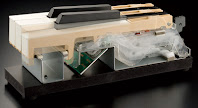 |
| PHAIII Advanced key action |
The Roland piano key actions all have 3 key sensors (just like Yamaha
& Kawai) with what I consider to be an exceptionally nice piano and instrumental sound sampling technology for a wide and smooth dynamic range which is evident when playing, and I
do enjoy that aspect of it very much. You can really express yourself on these pianos and feel like you are playing a real piano as I mentioned earlier. The keys themselves are plastic on all models whereas Yamaha & Kawai have wood keys on a few of their upper priced models. However, having all plastic keys is not a negative thing at all as long as they are good quality keys and properly weighted with graduated hammer style movement, which they are on the Roland pianos. In fact, some of my favorite digital pianos these days do not have wood keys and I have a great playing experience with those models and even prefer them.
 The
The
Roland key action also incorporates a grand piano simulation
movement with a “let-off/escapement mechanism” (left pic) which allows
for greater note repetition and dynamics. This key movement
simulates the key action feel of a grand piano as opposed to an upright
piano, and
of the major brands, only Roland & Kawai have this feature in
digital pianos retailing under $8000. When you press the keys down
slowly on a real grand piano, you can feel a slight hesitation or notch
about halfway down when the key action is moving and this is called the
escapement or let-off effect. Generally speaking, upright acoustic
pianos do not have this feature but grand pianos do. Is this
let-off/escapement feature a necessity for playing a piano?…not
really…but it’s cool to have because it does offer even better
note/key repetition and playing accuracy, especially for more advanced
players:) The piano keytops
are coated in a synthetic ivory material which duplicates the feel
of the older acoustic pianos which had real ivory keys. This substance
helps absorb sweat from the fingers and offers a smoother playing
experience. It also looks a bit classier than the all
white keys and I personally like the ivory key playing experience.
Roland piano keys in general tend to move and play a
bit faster/quicker, in my opinion, than the other brands including Yamaha & Kawai higher priced furniture cabinet pianos, and this can be a good thing
depending on the kind of music you play, your style of playing, and your
needs. Roland produces three different key actions for all of its pianos including the Ivory
Feel-S action in the HP503 which is not as good as their top-of-the-line
PHAIII Ivory Feel key action in the mid range HP505 and the HP507 & LX15. Roland uses
their less expensive Ivory Feel-G key action in their models
under $2000 which I personally do not like (key action is a bit sluggish
to push down, especially with playing flats & sharps) and I am
glad is not used in the HP and LX models. The lowest priced HP503 Ivory Feel-S keys
are designed and manufactured differently than the other models here and are
using a one piece key as opposed to a 2-piece laminated stronger key on the
PHAIII advanced action in the HP507 & LX15. The 2-piece laminated key with metal support is a
more durable sturdier key system and I do like it and would definitely pick that
over the lowest priced HP503 given a choice.
Both the HP507 & LX15 have identical digital functions including 128-note polyphony which seems to be more than enough piano note memory to handle advanced level complex piano playing as well as layering of two instrument sounds. Roland’s proprietary technology seems to take care of any potential note drop-out that could otherwise occur when playing at advanced skill levels. Even though a few other major digital piano brands now offer 256-note polyphony in their higher priced models, generally speaking, 128-note polyphony is more than adequate even when playing complex music, as I mentioned before, and I have never had an issue with it on these Roland pianos. The HP & LX
models offer many instrument sounds (many of which sound pretty realistic) divided into 5 control panel buttons above the keyboard. These sounds include 16 variations of acoustic pianos, 10 electric pianos, 14 string tones, and 307 additional instrument tones (just about anything you can think of including organs,
banjo, synth, sax, trumpet, sitar, guitars, individual drum sounds,
etc:) for a total of 347 tones which is a lot! You can see all of the
instrument names and other function descriptions in the LCD user display
screen which is very nice for displaying relevant
info.
The HP507 & LX15 have slightly better display screens than the lower priced Roland pianos which I have reviewed in an earlier post. You change
change the “tonality” of these pianos by increasing or decreasing the
brilliance or mellowness of the piano & instrument sounds and you
can take any two sounds and layer them together or split them separately on either side of the keyboard. The pianos also have the duet twin piano feature which lets you electronically divide the 88-keys into two identical 44-key keyboards playing the same notes in the same octaves so that two people can play the same music at the same time. It’s a great
feature for teacher-student, parent-child, etc, and many of the top
brands are including that feature in their pianos too. The HP307 & LX15 have 100 levels of touch sensitivity to give a person detailed control over the way the sound reacts to your touch as you play the keys. In other words, you can customize the reaction of the sound to your playing style depending if you normally strike the keys with more or less force. This can be helpful for not only professional players but also for beginners too.
As far as the built-in speaker/audio systems in these models, the HP507 has 140 watts of total audio power going into 4 amplifiers and 6
speakers and the LX15 has 160 watts of total audio power going into 4
amplifiers and 6 speakers. The HP507 and LX15 are taller pianos so that the 6
speakers can be laid out inside the pianos with 2 near the top, two near the keyboard, and two below. This system gives a more balanced approach to recreating the acoustic piano playing experience and it really makes the piano sound great. So it’s
not just the power or the internal audio systems themselves, but how and where these components are installed in the piano and how the individual piano tones are projected through those different speakers and amplifiers. Roland has been in
the professional pro audio business for many years so they have experience in this area and it shows in these digital pianos.
With regard to the piano pedals, they operate (move) quite smoothly and feel
good to press down, and they incorporate the three traditional pedal functions
(damper/sustain, sostenuto, and soft) of regular acoustic pianos. The pedals do work better than other digital pianos I have played and simulate a reasonably good pedal experience using a half pedaling feature with much longer sustain/decay time (than other digital pianos) giving you more sustain/decay levels as well as physically feeling like the pedal is changing resistance when being pressed down. Roland calls this feature Progressive Damper Action. Having good piano pedals is important, especially to more advanced players, so Roland does a good job in this way.
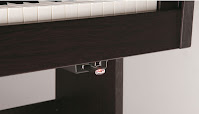 |
| USB ports |
A digital MIDI recorder is built into both models featuring 3 tracks of
recording and playback (for up to 3 separate instruments) and being able
to save the songs on a USB flash drive which is very cool. There is also
an audio wav file recorder which allows actual CD recording and
playback giving a precise rendition of your song which you can then play
along with or save on a USB flash drive for loading onto your computer
to use in notation programs or attach to emails to send to family &
friends, so they can hear you on their computers…lots of fun with that.
You can also plug in another instrument or microphone into the pianos
and record that sound along with the piano and combine them. You can
also use a key transpose feature on the pianos to transpose your
recording (including the external audio source) to another key for
singing or modulating the song up or down in semi-tones one step at a
time. Even playback speed of MIDI and audio song files can
be adjusted up or down which is very cool for audio and most digital
pianos cannot do this on audio wav/CD files. So that means you can play
along with your favorite CD song direct inside your piano and slow it down
to 75% of original speed to learn how to play it at a better (slower)
speed while learning…and it still sounds good (I have personally used this feature and it’s great). I have not seen
audio/CD song tempo control before on any other brand that has audio
record or playback.
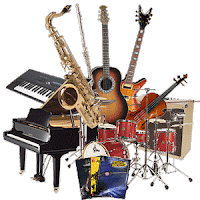 |
| General MIDI sound |
Both the Roland HP507 & LX15 models playback General MIDI song files
from a USB flash drive which is a great feature and one I use all the
time in my studio. The General MIDI song format allows you to play your
piano parts along “with the band or orchestra” and to interact with
multiple instruments at one time using well known piano lesson books including thousands of popular songs which can be found on the Internet.
For more info on the General MIDI format go here: General MIDI and Playing Piano.
Roland has a number of other ways its pianos can record music and playback songs for music education & learning that are quite useful and can be important when trying to learn music whether you are a
beginner or professional. But this comes as no surprise because for years Roland has built professional recording & music learning devices for musicians, teachers, and students who use them in their home or studio for more effective practice sessions. If you want to know more about this you are welcome to contact me.
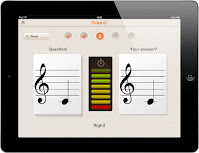 |
| Roland iPad App |
All Roland HP & LX models (including the lower price Roland HP505 & HP503) can connect directly to an iPad for another
interactive way of learning about music and playing the piano and I use
iPad piano learning/teaching apps in my studio and they are fun a
provide a cutting edge visual way of interactive piano practice and
learning. A unique feature of the Roland HP & LX pianos is that they
can wirelessly connect to an iPad using an optional Roland wireless USB
adapter and then utilizing a special iPad Roland piano education app
for a good interactive ways of building piano skills. The wireless connection also allows the iPad to serve as an instrument sound selector for the piano instead of using the actual sound selector buttons on the piano. This makes it easier and more intuitive to bring up the tones on the piano from the iPad using the Roland iPad app assuming you have an iPad in your home to use for that.
The HP507 and LX15 look most like real acoustic pianos because of their
design and extra height and the HP507 has a design feature
with a slide out key cover which is able to cover up just the control panel (left pic)
while you are playing, as opposed to the entire keyboard. This allows the piano to look clean and uncluttered while playing it instead of having the control panel always showing. I like the way this works and looks although for me
I would seldom use this feature because I use the buttons and features on the control panel too often while I am playing and having the control panel covered over would just get in my way. But for those people who will simply be using one sound most of the time while playing, then it
is a nice design touch to have.
| LX15 ebony with closed cover |
Overall, I really like these Roland pianos and recommend them because
they have a simple, fairly easy to use control panel right in front of
you (instead of off to the side), the key action is enjoyable to play
and moves well, the piano sound is very good and has a wide dynamic
range which is sensitive to key pressure in a smooth way as well as
many of the other instrument sounds, the cabinet designs and colors are
attractive for most people (polished ebony is my favorite)
and the features including recording, playback, etc, are fun and useful.
The HP507 and LX15 are virtually the same pianos except for cabinet
design and colors offered and if I was not held down by a budget, my
favorite model would be the LX15 in polished ebony…I really like the way it looks. The LX15 also comes in a polished white as well and looks beautiful. By the way, I have seen other brands of digital pianos which appear to be similar in design and color to the HP507 & LX15, but for less money, but I have played these pianos and they don’t come anywhere near the Roland pianos as far as tone and touch is concerned and would be half as good as these Roland models. You do get what you pay for most of the time.
| Roland LX15 w/optional grand bench |
Just so people don’t think I only say good things about pianos I like (and I do like these Roland pianos), one of the slightly negative things I noticed on these models reviewed
here was the key actions were a bit noisy when the keys hit the bottom
keybed underneath the key when playing with a bit more finger force at a quieter piano volume, which it easy to do on digital pianos. However, even regular acoustic pianos
have some key movement noise when pressing on the keys, and when the
volume of a regular acoustic piano is loud, as it normally is, you rarely hear the key noise anyway because acoustic pianos have no volume control knob (like digital pianos) so they are always loud or louder in volume, so there is key action noise on all pianos to some degree. However, at the end of the day, if
you want a satisfying piano playing experience without an overabundance
of digital features that you may not use very often (no drum rhythm
patterns, no automatic chord styles), the Roland HP507 and
LX15 would be a great choice depending on your budget, and I do
recommend them.
If you want more info on new digital pianos and LOWER PRICES than internet discounts, please email me at tim@azpianowholesale.com or call direct at 602-571-1864.






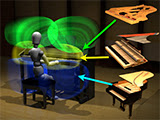











The discount prices for the Roland HP507 at $4499 and the Roland LX15 at $5999 seem costly when compared to the better touch and speakers I've heard about in the Kawai CA95 and CS10. I'll look forward to your review and top recommendations, if you do a comparison test.
By the way, your digital pianos reviews are the most accurate and unbiased I've seen.
I agree with anonymous 1, the reviews are awesome. I'm very impressed by the LX15, but the cost made me jump. DO I have that money, noooo…